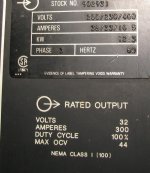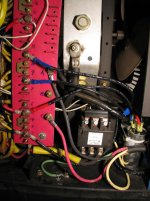I am in no way qualified to come up with this idea. This conversion worked wonderfully and I owe it all to the information that David Kamp gave on the Practical Machinist web site and in emails to me.
I highly recommend you read through these useful links:
http://www.practicalmachinist.com/v...ler-cp200-converted-240v-single-phase-199832/
http://pounceatron.dreamhosters.com/docs/misc/CP-200_Single-Phase_Step-By-Step.pdf
I can not stress enough to read everything he writes and pay atention to the wiring diagrams and the actual wiring of the machine. If ANYTHING is different, you need to stop and figure out what changes you need to make to the procedures. Insert normal disclaimers here: You are working with electricity. If you do not know what you are doing or make a mistake, you could burn down your building or injure/kill yourself. Make sure you understand what you are doing, take appropriate precautions, and do not rely upon the information published here. What follows is what I did. I make no claim that you should attempt this nor that it is safe to do so. Use at your own risk.
Here is my machine. Please note the face plate specifications and the wiring diagram.
I highly recommend you read through these useful links:
http://www.practicalmachinist.com/v...ler-cp200-converted-240v-single-phase-199832/
http://pounceatron.dreamhosters.com/docs/misc/CP-200_Single-Phase_Step-By-Step.pdf
I can not stress enough to read everything he writes and pay atention to the wiring diagrams and the actual wiring of the machine. If ANYTHING is different, you need to stop and figure out what changes you need to make to the procedures. Insert normal disclaimers here: You are working with electricity. If you do not know what you are doing or make a mistake, you could burn down your building or injure/kill yourself. Make sure you understand what you are doing, take appropriate precautions, and do not rely upon the information published here. What follows is what I did. I make no claim that you should attempt this nor that it is safe to do so. Use at your own risk.
Here is my machine. Please note the face plate specifications and the wiring diagram.

















